Research Progress on Low Damage Grasping of Fruit, Vegetable and Meat Raw Materials
Abstract
:1. Introduction
2. Research Progress of Fruit, Vegetable and Meat Grippers
2.1. Electric Grippers
2.2. Pneumatic Grippers
2.3. Vacuum Grippers
2.4. Magnetic Grippers
3. Research Progress of Control Strategies for Grasping
3.1. Control Strategy Based on Visual Sensors
3.2. Control Strategy Based on Tactile Sensors
4. Future Development Trends
Author Contributions
Funding
Data Availability Statement
Conflicts of Interest
References
- Peng, Y.; Liu, Y.G.; Yang, Y.; Yang, Y.; Liu, N.; Sun, Y. Research progress on application of soft robotic gripper in fruit and vegetable picking. Trans. Chin. Soc. Agric. Eng. 2018, 34, 11–20. [Google Scholar] [CrossRef]
- Peng, L. Development of Under-Actuated Manipulator for Apple Picking. Master’s Thesis, Nanjing Agricultural University, Nanjing, China, 2010. [Google Scholar] [CrossRef]
- Qiao, H.; Zhong, S.L.; Chen, Z.Y.; Wang, H.Z. Improving performance of robots using human-inspired approaches: A survey. Sci. China Inform. Sci. 2022, 65, 5–35. [Google Scholar] [CrossRef]
- Li, Q.C.; Hu, T.; Wu, C.Y.; Hu, X.D.; Ying, Y.B. Review of end-effectors in fruit and vegetable harvesting robot. Trans. Chin. Soc. Agric. Mach. 2008, 39, 175–179. [Google Scholar]
- Song, J.; Zhang, T.Z.; Xu, L.M.; Tang, X.Y. Research Actuality and Prospect of Picking Robot for Fruits and Vegetables. Trans. Chin. Soc. Agric. Mach. 2006, 37, 158–162. [Google Scholar] [CrossRef]
- Zhang, B.H.; Xie, Y.X.; Zhou, J.; Wang, K.; Zhang, Z. State-of-the-art robotic grippers, grasping and control strategies, as well as their applications in agricultural robots: A review. Comput. Electron. Agric. 2020, 177, 105694. [Google Scholar] [CrossRef]
- Kumar, B. Material compositions affects vacuum system in gripping technology. Int. J. Sci. Technol. 2017, 7, 15–23. Available online: https://www.researchgate.net/publication/314188104 (accessed on 8 June 2023).
- Zhang, Y.N.; Zhang, R.F.; Sun, Y.; Zheng, E.L.; Sun, G.X.; Wang, X.S. Effects of local compression on the mechanical damage of tomato with different maturity. Trans. Chin. Soc. Agric. Eng. 2021, 37, 292–298. [Google Scholar] [CrossRef]
- Li, N. End-Effector Design and Target Recognition of Apple Picking Robot. Master’s Thesis, Shandong Agricultural University, Tai’an, China, 2022. [Google Scholar] [CrossRef]
- Jin, B.; Lin, L.X. Design and force control of an underactuated robotic hand for fruit and vegetable picking. J. Mech. Eng. 2014, 50, 1–8. [Google Scholar] [CrossRef]
- Li, Z.G.; Liu, J.Z.; Li, P.P. Relationship between mechanical property and damage of tomato during robot harvesting. Trans. Chin. Soc. Agric. Eng. 2010, 26, 112–116. [Google Scholar]
- Zhang, F.; Chen, Z.J.; Wang, Y.F.; Bao, R.F.; Chen, X.G.; Fu, S.L.; Tian, M.M.; Zhang, Y.K. Research on Flexible End-Effectors with Humanoid Grasp Function for Small Spherical Fruit Picking. Agriculture 2023, 13, 123. [Google Scholar] [CrossRef]
- Ali, M.H.; Zhanabayev, A.; Khamzhin, S.; Mussin, K. Biologically Inspired Gripper Based on the Fin Ray Effect. In Proceedings of the 5th International Conference on Control, Automation and Robotics (ICCAR), Beijing, China, 19–22 April 2019. [Google Scholar] [CrossRef]
- Guo, T.Z.; Zheng, Y.F.; Bo, W.X.; Liu, J.; Pi, J.; Chen, W.; Deng, J.Z. Research on the Bionic Flexible End-Effector Based on Tomato Harvesting. J. Sens. 2022, 2022, 2564952. [Google Scholar] [CrossRef]
- Xiao, X.; Wang, Y.N.; Jiang, Y.M. End-Effectors Developed for Citrus and Other Spherical Crops. Appl. Sci. 2022, 12, 7945. [Google Scholar] [CrossRef]
- Zhang, H. Design of Shape Adaptive Compliant Grasper and Research of Grasping Force Sensing Method. Master’s Thesis, Harbin Institute of Technology, Harbin, China, 2020. [Google Scholar] [CrossRef]
- Liu, C.H.; Chiu, C.H. Design and Prototype of Monolithic Compliant Grippers for Adaptive Grasping. In Proceedings of the 3rd International Conference on Control and Robotics Engineering (ICCRE), Nagoya, Japan, 20–23 April 2018. [Google Scholar] [CrossRef]
- Liu, C.H.; Chiu, C.H.; Chen, T.L.; Pai, T.Y.; Chen, Y.; Hsu, M.C. A Soft Robotic Gripper Module with 3D Printed Compliant Fingers for Grasping Fruits. In Proceedings of the IEEE/ASME International Conference on Advanced Intelligent Mechatronics (AIM), Auckland, New Zealand, 9–12 July 2018. [Google Scholar] [CrossRef]
- Miao, Y.B.; Zheng, J.F. Optimization design of compliant constant-force mechanism for apple picking actuator. Comput. Electron. Agric. 2020, 170, 105232. [Google Scholar] [CrossRef]
- Wang, A.X. Optimizing Study of Tomato Picking Manipulator. Master’s Thesis, Jilin University, Changchun, China, 2022. [Google Scholar] [CrossRef]
- Ji, W.; Qian, Z.J.; Xu, B.; Tang, W.; Li, J.L.; Zhao, D.A. Grasping damage analysis of apple by end-effector in harvesting robot. J. Food Process Eng. 2017, 40, e12589. [Google Scholar] [CrossRef]
- Catchpole, K.R.; Giddings, A.E.B.; Wilkinson, M.; Hirst, G.; Dale, T.; de Leval, M.R. Improving patient safety by identifying latent failures in successful operations. Surgery 2007, 142, 102–110. [Google Scholar] [CrossRef]
- Heijnsdijk, E.A.M.; Pasdeloup, A.; van der Pijl, A.J.; Dankelman, J.; Gouma, D.J. The influence of force feedback and visual feedback in grasping tissue laparoscopically. Surg. Endosc. 2004, 18, 980–985. [Google Scholar] [CrossRef]
- Van Assenbergh, P.; Culmone, C.; Breedveld, P.; Dodou, D. Implementation of anisotropic soft pads in a surgical gripper for secure and gentle grip on vulnerable tissues. Proc. Inst. Mech. Eng. Part H J. Eng. Med. 2020, 235, 255–263. [Google Scholar] [CrossRef]
- Ilievski, F.; Mazzeo, A.D.; Shepherd, R.E.; Chen, X.; Whitesides, G.M. Soft Robotics for Chemists. Angew. Chem. Int. Ed. 2011, 50, 1890–1895. [Google Scholar] [CrossRef]
- Blanes, C.; Mellado, M.; Ortiz, C.; Valera, A. Technologies for robot grippers in pick and place operations for fresh fruits and vegetables. Span. J. Agric. Res. 2011, 9, 1130–1141. [Google Scholar] [CrossRef]
- Gorissen, B.; Reynaerts, D.; Konishi, S.; Yoshida, K.; Kim, J.W.; De Volder, M. Elastic Inflatable Actuators for Soft Robotic Applications. Adv. Mater. 2017, 29, 1604977. [Google Scholar] [CrossRef] [PubMed]
- Low, J.H.; Lee, W.W.; Khin, P.M.; Thakor, N.V.; Kukreja, S.L.; Ren, H.L.; Yeow, C.H. Hybrid Tele-Manipulation System Using a Sensorized 3-D-Printed Soft Robotic Gripper and a Soft Fabric-Based Haptic Glove. IEEE Robot. Autom. Lett. 2017, 2, 880–887. [Google Scholar] [CrossRef]
- Wang, N.F.; Ge, X.D.; Guo, H.; Cui, C.Y.; Zhang, X.M. A kind of soft pneumatic actuator based on multi-material 3D print technology. In Proceedings of the IEEE International Conference on Robotics and Biomimetics (ROBIO), Macau, China, 5–8 December 2017. [Google Scholar] [CrossRef]
- Salem, M.E.M.; Wang, Q.; Wen, R.S.; Xiang, M. Design and Characterization of Soft Pneumatic Actuator for Universal Robot Gripper. In Proceedings of the International Conference on Control and Robots (ICCR), Hong Kong, China, 15–17 August 2018. [Google Scholar] [CrossRef]
- Zhou, K.H. Research and Design of the Robotic End-Effectors for Tomato Holding. Master’s Thesis, Jiangsu University, Zhenjiang, China, 2022. [Google Scholar] [CrossRef]
- Lei, J.; Ge, Z.H.; Fan, P.J.; Zou, W.; Jiang, T.; Dong, L. Design and Manufacture of a Flexible Pneumatic Soft Gripper. Appl. Sci. 2022, 12, 6306. [Google Scholar] [CrossRef]
- Li, J.; Dai, C.Y.; Wang, Y.W.; Cha, F.S.; Miao, W.L. Development of pneumatic four blade soft grasp for grabbing strawberry. J. Hrb. Inst. Technol. 2022, 54, 105–113. [Google Scholar] [CrossRef]
- Miron, G.; Bedard, B.; Plante, J.S. Sleeved Bending Actuators for Soft Grippers: A Durable Solution for High Force-to-Weight Applications. Actuators 2018, 7, 40. [Google Scholar] [CrossRef]
- Wang, Z.; Or, K.; Hirai, S. A dual-mode soft gripper for food packaging. Robot. Auton. Syst. 2020, 125, 103427. [Google Scholar] [CrossRef]
- Monkman, G.J.; Hesse, S.; Steinmann, R.; Schunk, H. Robot Grippers; Wiley-VCH Verlag GmbH & Co. KGaA: Weinheim, Germany, 2007; pp. 176–199. [Google Scholar]
- Stommel, M.; Xu, W.L.; Lim, P.P.K.; Kadmiry, B. Robotic Sorting of Ovine Offal: Discussion of a Soft Peristaltic Approach. Soft Robot. 2014, 1, 246–254. [Google Scholar] [CrossRef]
- Jørgensen, T.B.; Hansen, B.R.; Pedersen, M.M.; Krüger, N.; Hansen, N.W. A Flexible Suction Based Grasp Tool and Associated Grasp Strategies for Handling Meat. In Proceedings of the 2018 4th International Conference on Mechatronics and Robotics Engineering, Valenciennes, France, 7–11 February 2018. [Google Scholar] [CrossRef]
- Jørgensen, T.B.; Jensen, S.H.N.; Aanaes, H.; Hansen, N.W.; Krüger, N. An Adaptive Robotic System for Doing Pick and Place Operations with Deformable Objects. J. Intell. Robot. Syst. 2019, 94, 81–100. [Google Scholar] [CrossRef]
- Rusu, R.B.; Cousins, S. 3D is here: Point Cloud Library (PCL). In Proceedings of the IEEE International Conference on Robotics and Automation (ICRA), Shanghai, China, 9 May 2011. [Google Scholar] [CrossRef]
- Ross, S.; Korostynska, O.; Cordova-Lopez, L.E.; Mason, A. A review of unilateral grippers for meat industry automation. Trends Food Sci. Tech. 2022, 119, 309–319. [Google Scholar] [CrossRef]
- Petterson, A.; Ohlsson, T.; Caldwell, D.G.; Davis, S.; Gray, J.O.; Dodd, T.J. A Bernoulli principle gripper for handling of planar and 3D (food) products. Ind. Robot. 2010, 37, 518–526. [Google Scholar] [CrossRef]
- Pettersson, A.; Davis, S.; Gray, J.O.; Dodd, T.J.; Ohlsson, T. Design of a magnetorheological robot gripper for handling of delicate food products with varying shapes. J. Food Eng. 2009, 98, 332–338. [Google Scholar] [CrossRef]
- Choi, D.S.; Kim, T.H.; Lee, S.H.; Pang, C.; Bae, J.W.; Kim, S.Y. Beyond Human Hand: Shape-Adaptive and Reversible Magnetorheological Elastomer-Based Robot Gripper Skin. ACS Appl. Mater. Interfaces 2020, 12, 44147–44155. [Google Scholar] [CrossRef] [PubMed]
- Lu, Q.; Choi, K.; Nam, J.D.; Choi, H.J. Magnetic Polymer Composite Particles: Design and Magnetorheology. Polymers 2021, 13, 512. [Google Scholar] [CrossRef]
- Hafeez, M.A.; Usman, M.; Umer, M.A.; Hanif, A. Recent Progress in Isotropic Magnetorheological Elastomers and Their Properties: A Review. Polymers 2020, 12, 3023. [Google Scholar] [CrossRef] [PubMed]
- Hong, S.W.; Yoon, J.Y.; Kim, S.H.; Lee, S.K.; Kim, Y.R.; Park, Y.J.; Kim, G.W.; Choi, S.B. 3D-Printed Soft Structure of Polyurethane and Magnetorheological Fluid: A Proof-of-Concept Investigation of its Stiffness Tunability. Micromachines 2019, 10, 655. [Google Scholar] [CrossRef]
- Cao, X.F.; Xuan, S.H.; Sun, S.S.; Xu, Z.B.; Li, J.; Gong, X.L. 3D Printing Magnetic Actuators for Biomimetic Applications. ACS Appl. Mater. 2021, 13, 30127–30136. [Google Scholar] [CrossRef] [PubMed]
- Fujita, T.; Shimada, K. Characteristics and Applications of Magnetorheological Fluids. J. Mag. Soc. Jpn. 2003, 27, 91–100. [Google Scholar]
- Zhu, X.C.; Jing, X.J.; Cheng, L. Magnetorheological fluid dampers: A review on structure design and analysis. J. Int. Mater. Syst. Struct. 2012, 23, 839–873. [Google Scholar] [CrossRef]
- Tsugami, Y.; Barbié, T.; Tadakuma, K.; Nishida, T. Development of universal parallel gripper using reformed magnetorheological fluid. In Proceedings of the 11th Asian Control Conference (ASCC), Gold Coast, QLD, Australia, 17–20 December 2017. [Google Scholar] [CrossRef]
- Tsugami, Y.; Nishida, T. Simple Structured Gripper Using Electromagnet and Permanent Magnet. In Proceedings of the International Conference on ICT Robotics 2017, Kagoshima, Japan, 25–26 November 2017; Available online: https://www.researchgate.net/publication/321296262 (accessed on 10 June 2023).
- Guan, R.H.; Zheng, H.Y.; Liu, Q.X.; Ou, K.T.; Li, D.S.; Fan, J.; Fu, Q.; Sun, Y.Y. DIW 3D printing of hybrid magnetorheological materials for application in soft robotic grippers. Compos. Sci. Technol. 2022, 223, 109409. [Google Scholar] [CrossRef]
- Wang, K.; Zhang, H.; Cao, Y.H.; Yi, J.F.; Yuan, X.F.; Wang, Y.N. Intelligent robots and key technologies for pharmaceutical production. Comput. Integr. Manuf. Sys. 2022, 28, 1981–1995. [Google Scholar] [CrossRef]
- Parness, A.; Frost, M.; King, J.A.; Thatte, N.; Witkoe, K.; Nevarez, M.; Garrett, M.; Aghazarian, H.; Kennedy, B. Video presentation of a rock climbing robot. In Proceedings of the 2013 IEEE/RSJ International Conference on Intelligent Robots and Systems (IROS 2013), Tokyo, Japan, 3–7 November 2013. [Google Scholar] [CrossRef]
- Parness, A.; Abcouwer, N.; Fuller, C.; Wiltsie, N.; Nash, J.; Kennedy, B. LEMUR 3: A limbed climbing robot for extreme terrain mobility in space. In Proceedings of the 2017 IEEE International Conference on Robotics and Automation (ICRA), Singapore, 29 May–3 June 2017. [Google Scholar] [CrossRef]
- Zhao, Y.S.; Gong, L.; Huang, Y.X.; Liu, C.L. A review of key techniques of vision-based control for harvesting robot. Comput. Electron. Agric. 2016, 127, 311–323. [Google Scholar] [CrossRef]
- Chen, Y.; Wang, S.C.; Bi, J.; Ai, H. Study on visual positioning and evaluation of automatic evisceration system of chicken. Food Bioprod. Process. 2020, 124, 222–232. [Google Scholar] [CrossRef]
- Cheng, C.P. Research on Robot Grasping Based on Improved Grasp Quality Convolutional Neural Network. Master’s Thesis, Xiangtan University, Xiangtan, China, 2019. [Google Scholar] [CrossRef]
- Boutry, C.M.; Negre, M.; Jorda, M.; Vardoulis, O.; Chortos, A.; Khatib, O.; Bao, Z.N. A hierarchically patterned, bioinspired e-skin able to detect the direction of applied pressure for robotics. Sci. Robot. 2018, 3, eaau6914. [Google Scholar] [CrossRef]
- Yang, D.; Guo, H.Y.; Chen, X.Y.; Wang, L.F.; Jiang, P.; Zhang, W.Q.; Zhang, L.Q.; Wang, Z.L. A flexible and wide pressure range triboelectric sensor array for real-time pressure detection and distribution mapping. J. Mater. Chem. A 2020, 8, 23827–23833. [Google Scholar] [CrossRef]
- Hua, Q.L.; Sun, J.L.; Liu, H.T.; Bao, R.R.; Yu, R.M.; Zhai, J.Y.; Pan, C.F.; Wang, Z.L. Skin-inspired highly stretchable and conformable matrix networks for multifunctional sensing. Nat. Commun. 2018, 9, 244. [Google Scholar] [CrossRef] [PubMed]
- Wang, X.W.; Gu, Y.; Xiong, Z.P.; Cui, Z.; Zhang, T. Electronic Skin: Silk-Molded Flexible, Ultrasensitive, and Highly Stable Electronic Skin for Monitoring Human Physiological Signals. Adv. Mater. 2014, 26, 1336–1342. [Google Scholar] [CrossRef] [PubMed]
- Zhu, H.F.; Wang, X.W.; Liang, J.; Lv, H.L.; Tong, H.Y.; Ma, L.B.; Hu, Y.; Zhu, G.Y.; Zhang, T.; Tie, Z.X.; et al. Versatile Electronic Skins for Motion Detection of Joints Enabled by Aligned Few-Walled Carbon Nanotubes in Flexible Polymer Composites. Adv. Funct. Mater. 2017, 27, 1606604. [Google Scholar] [CrossRef]
- Liu, F.; Han, F.; Ling, L.; Li, J.H.; Zhao, S.F.; Zhao, T.; Liang, X.W.; Zhu, D.L.; Zhang, G.P.; Sun, R.; et al. An Omni-Healable and Highly Sensitive Capacitive Pressure Sensor with Microarray Structure. Chem. Eur. J. 2018, 24, 16823–16832. [Google Scholar] [CrossRef]
- Gao, Y.J.; Ota, H.; Schaler, E.W.; Chen, K.; Zhao, A.; Gao, W.; Fahad, H.M.; Leng, Y.G.; Zheng, A.Z.; Xiong, F.R.; et al. Wearable Microfluidic Diaphragm Pressure Sensor for Health and Tactile Touch Monitoring. Adv. Mater. 2017, 29, 1701985. [Google Scholar] [CrossRef]
- Dahiya, R.S.; Cattin, D.; Adami, A.; Collini, C.; Barboni, L.; Valle, M.; Lorenzelli, L.; Oboe, R.; Metta, G.; Brunetti, F. Towards Tactile Sensing System on Chip for Robotic Applications. IEEE Sens. J. 2011, 11, 3216–3226. [Google Scholar] [CrossRef]
- Fishel, J.A.; Santos, V.J.; Loeb, G.E. A robust micro-vibration sensor for biomimetic fingertips. In Proceedings of the 2008 2nd IEEE RAS & EMBS International Conference on Biomedical Robotics and Biomechatronics, Scottsdale, AZ, USA, 19–22 October 2008. [Google Scholar] [CrossRef]
- Wang, L.; Wang, B.W.; Weng, L.; Huang, W.M.; Sun, Y. Magnetostrictive tactile sensor array and its application in grasping objects by manipulator. Chin. J. Sci. Instrum. 2020, 41, 91–98. [Google Scholar] [CrossRef]
- Hui, W.S.; Li, H.J.; Chen, M.; Song, A.G. Robotic tactile recognition and adaptive grasping control based on CNN-LSTM. Chin. J. Sci. Instrum. 2019, 40, 211–218. [Google Scholar] [CrossRef]
- Wang, Z.K.; Hirai, S.; Kawamura, S. Challenges and Opportunities in Robotic Food Handling: A Review. Front. Robot. AI 2022, 8, 789107. [Google Scholar] [CrossRef] [PubMed]
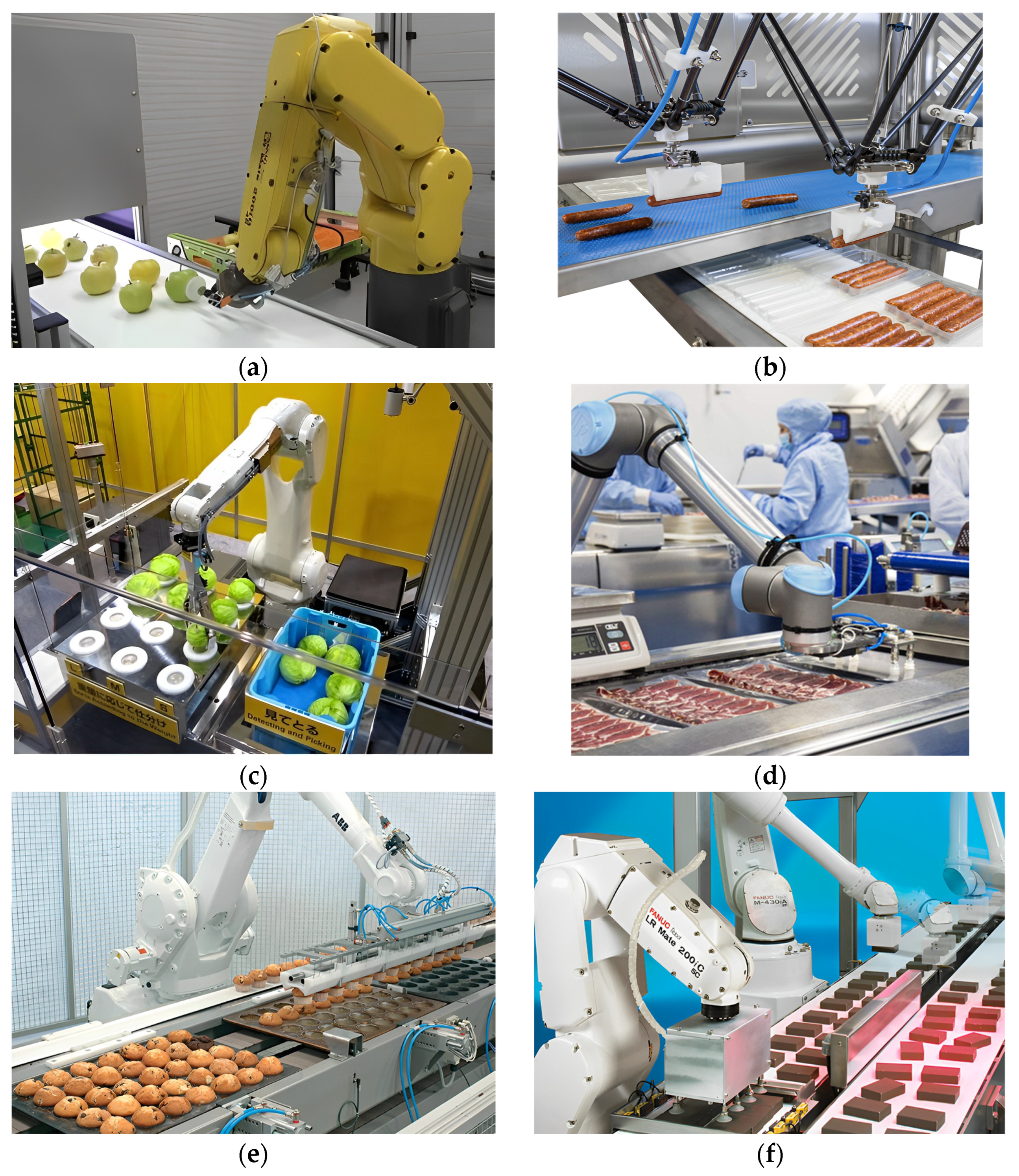
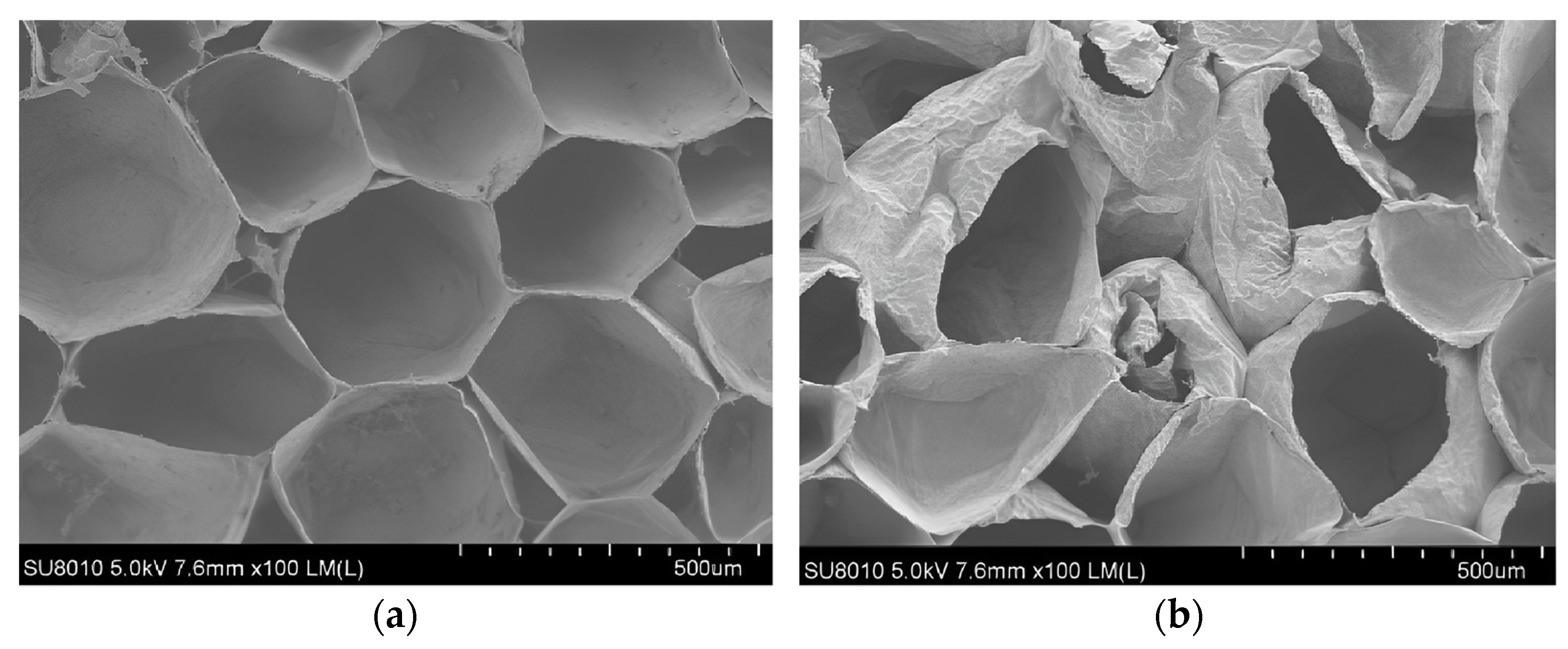
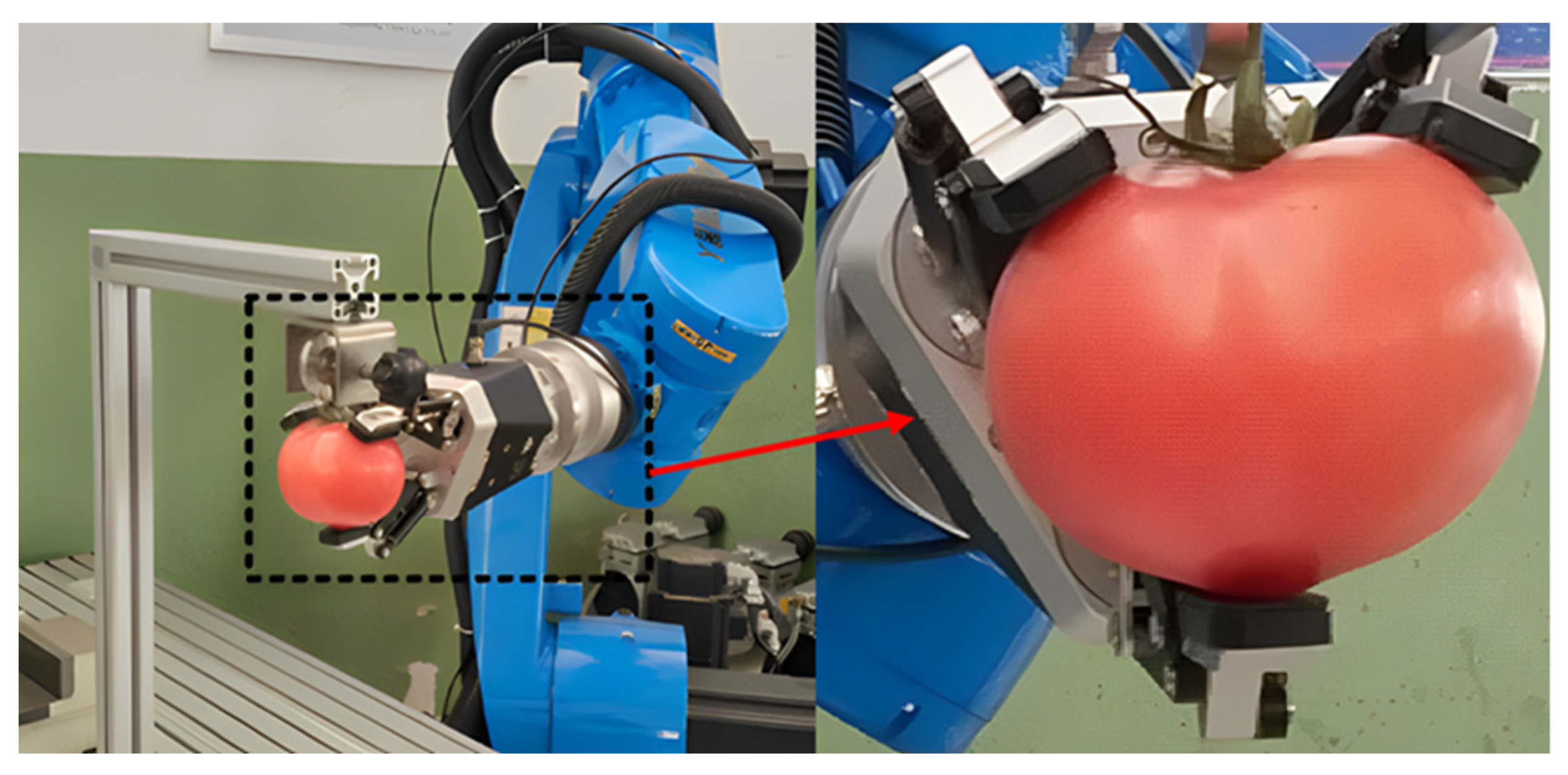
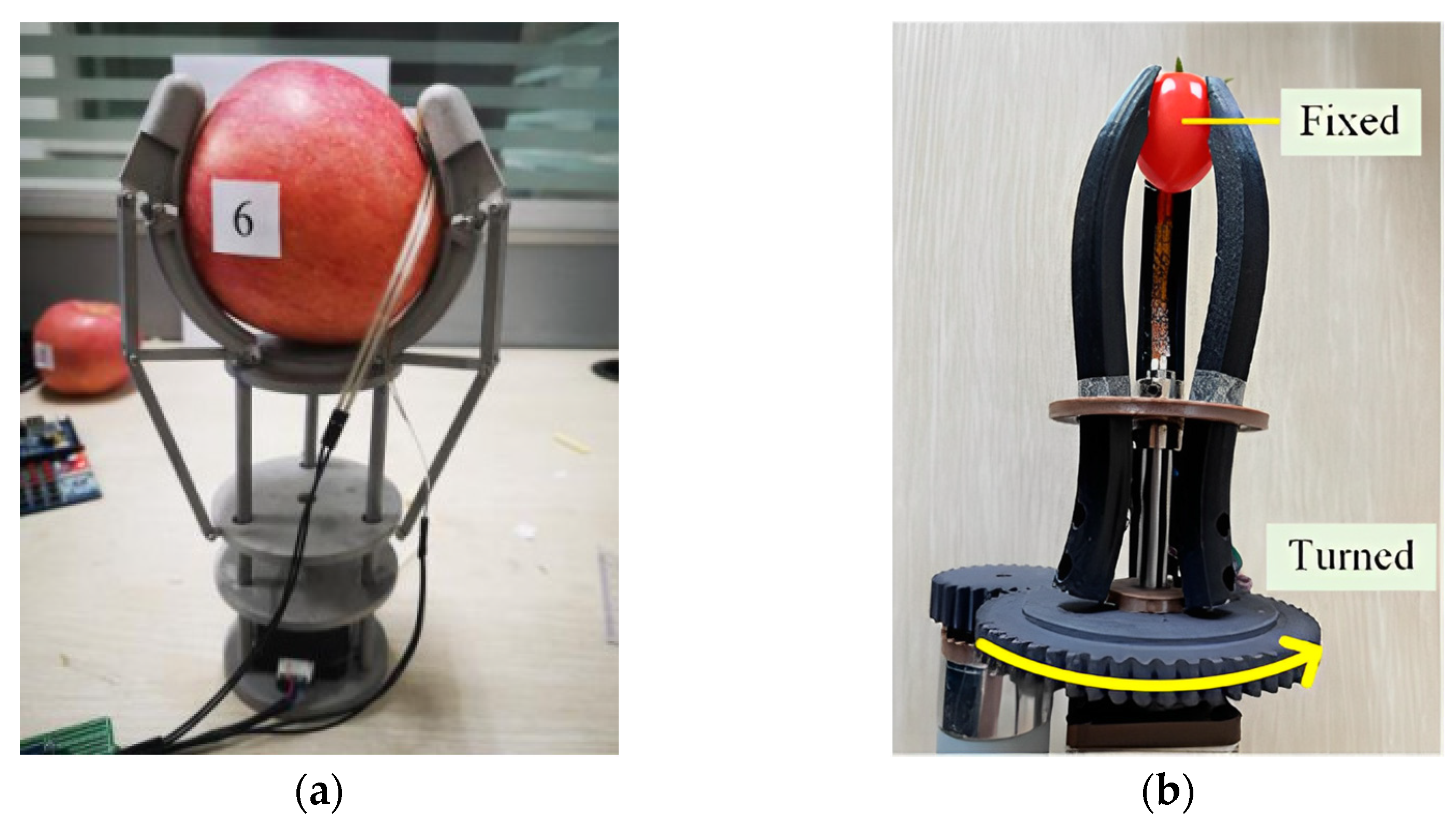
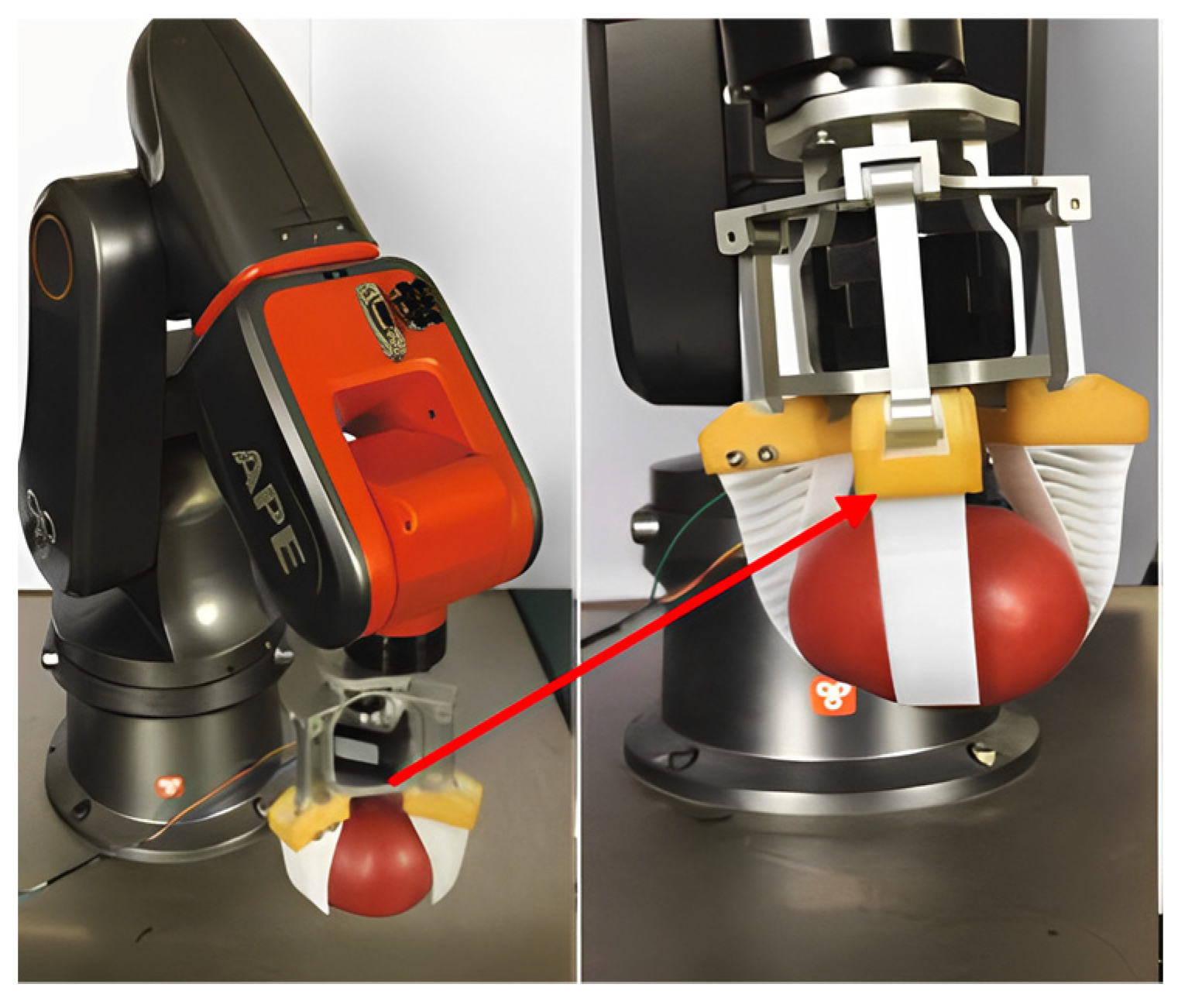
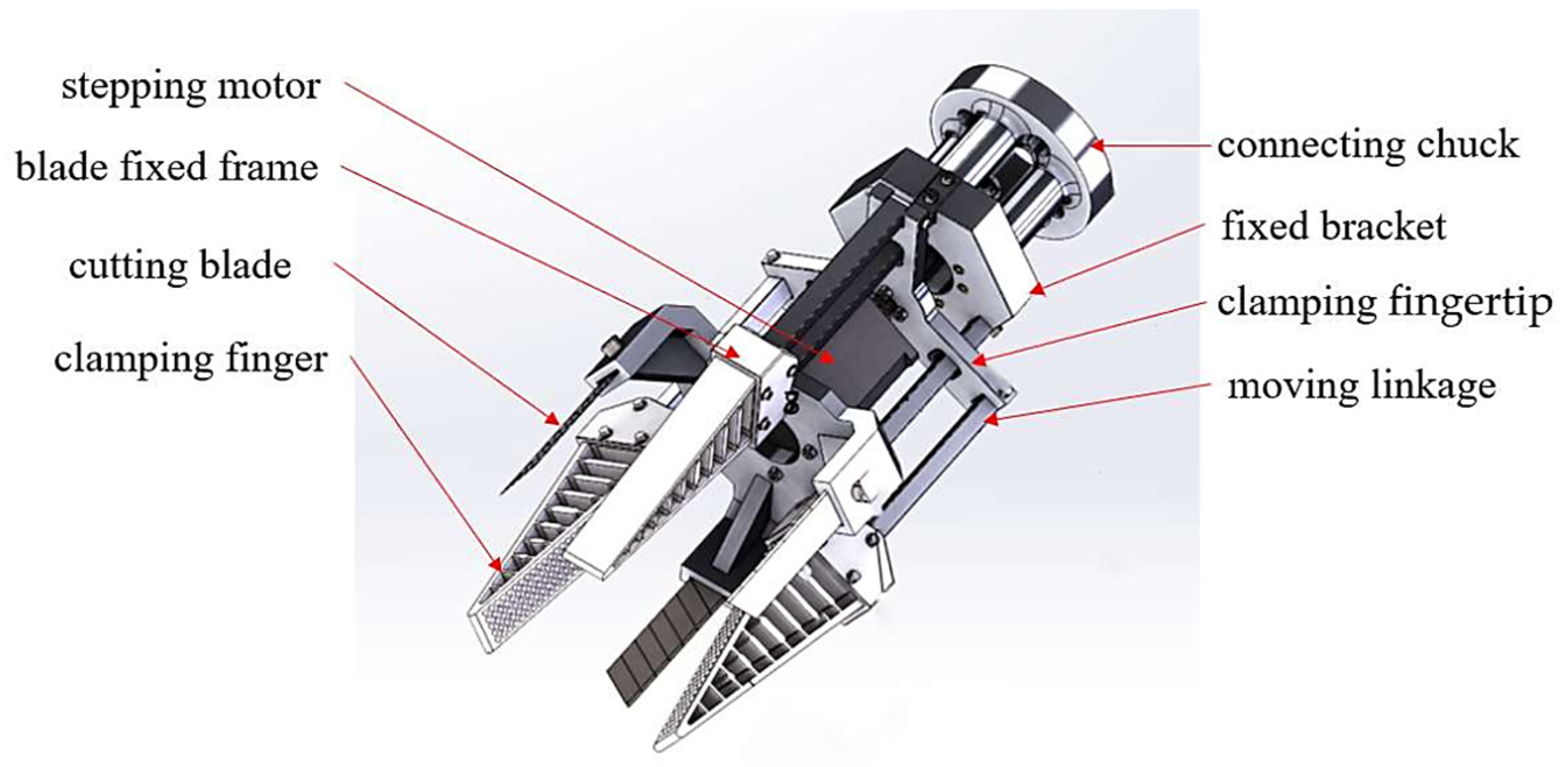

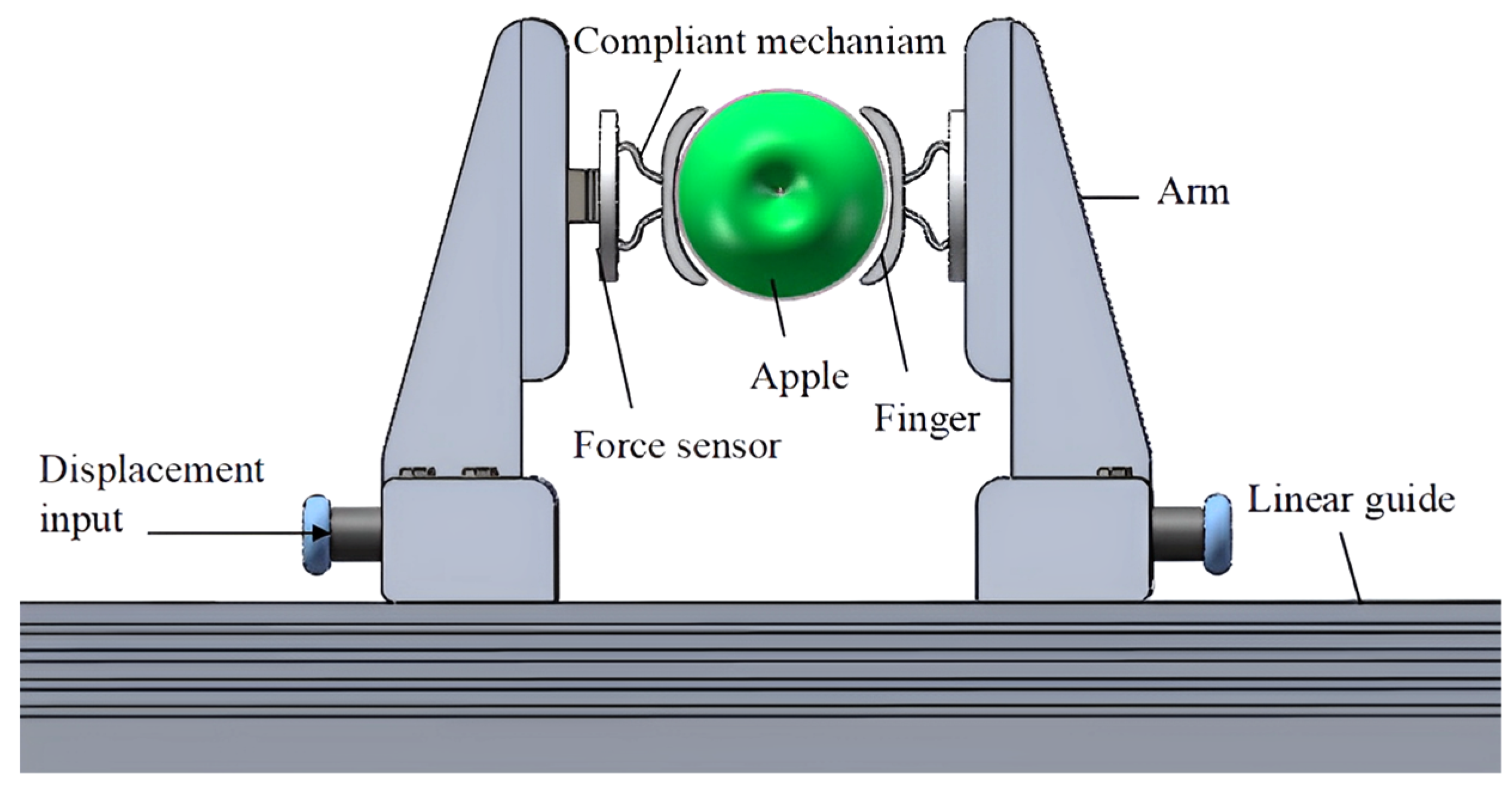
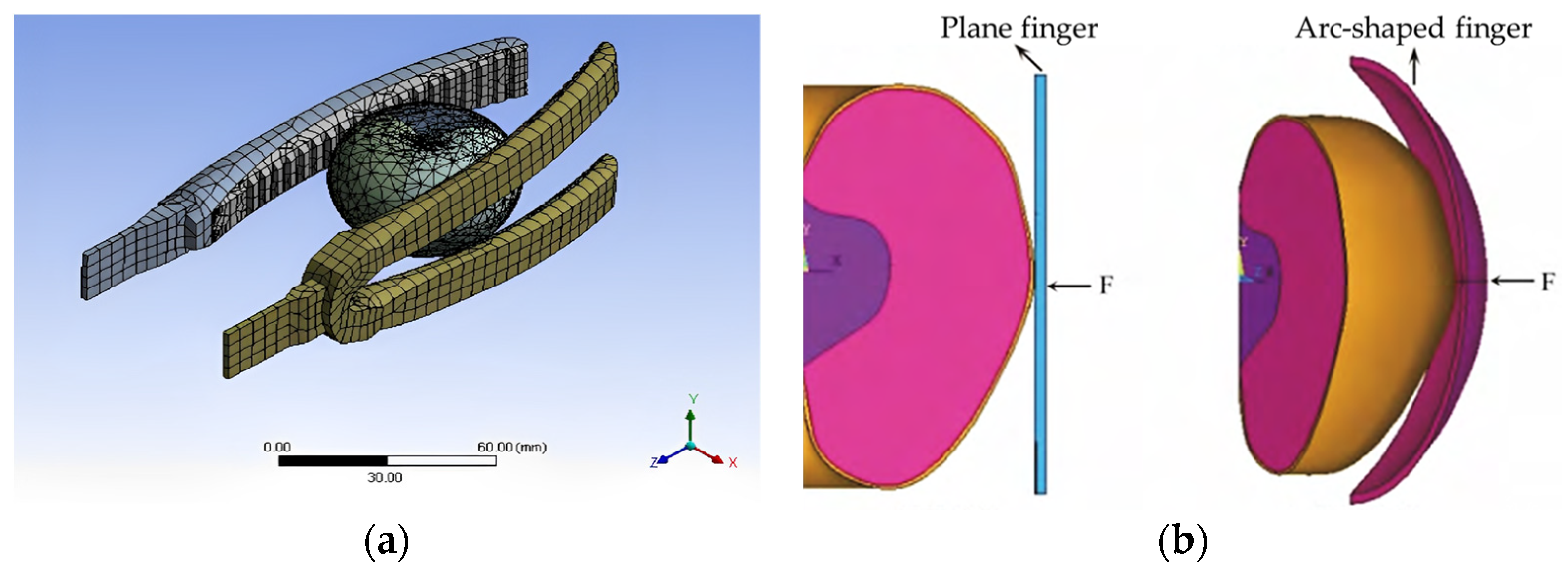

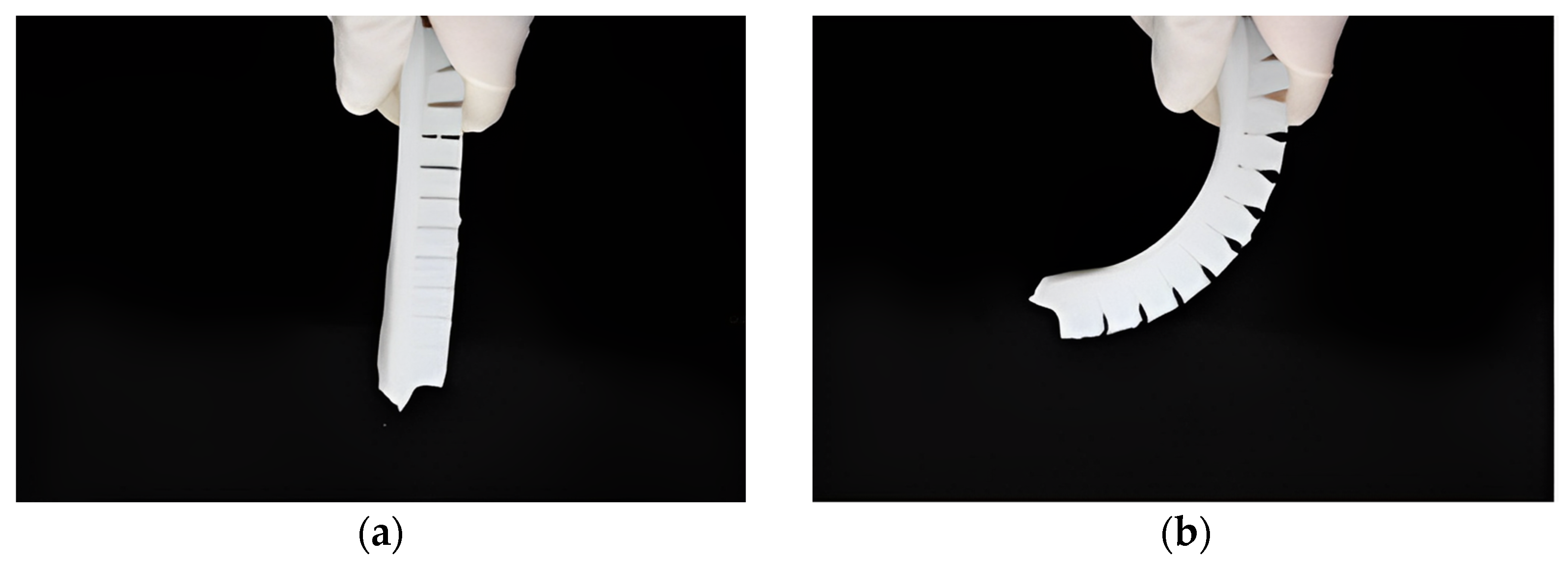
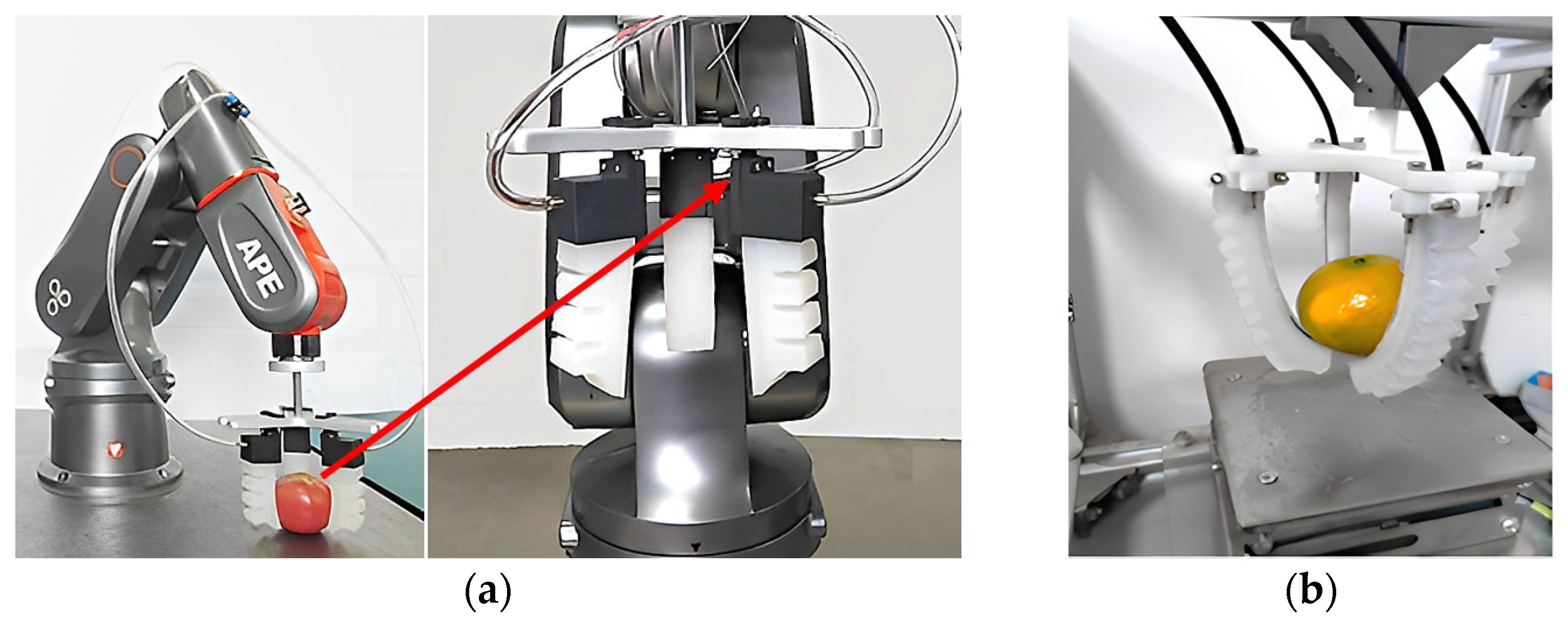
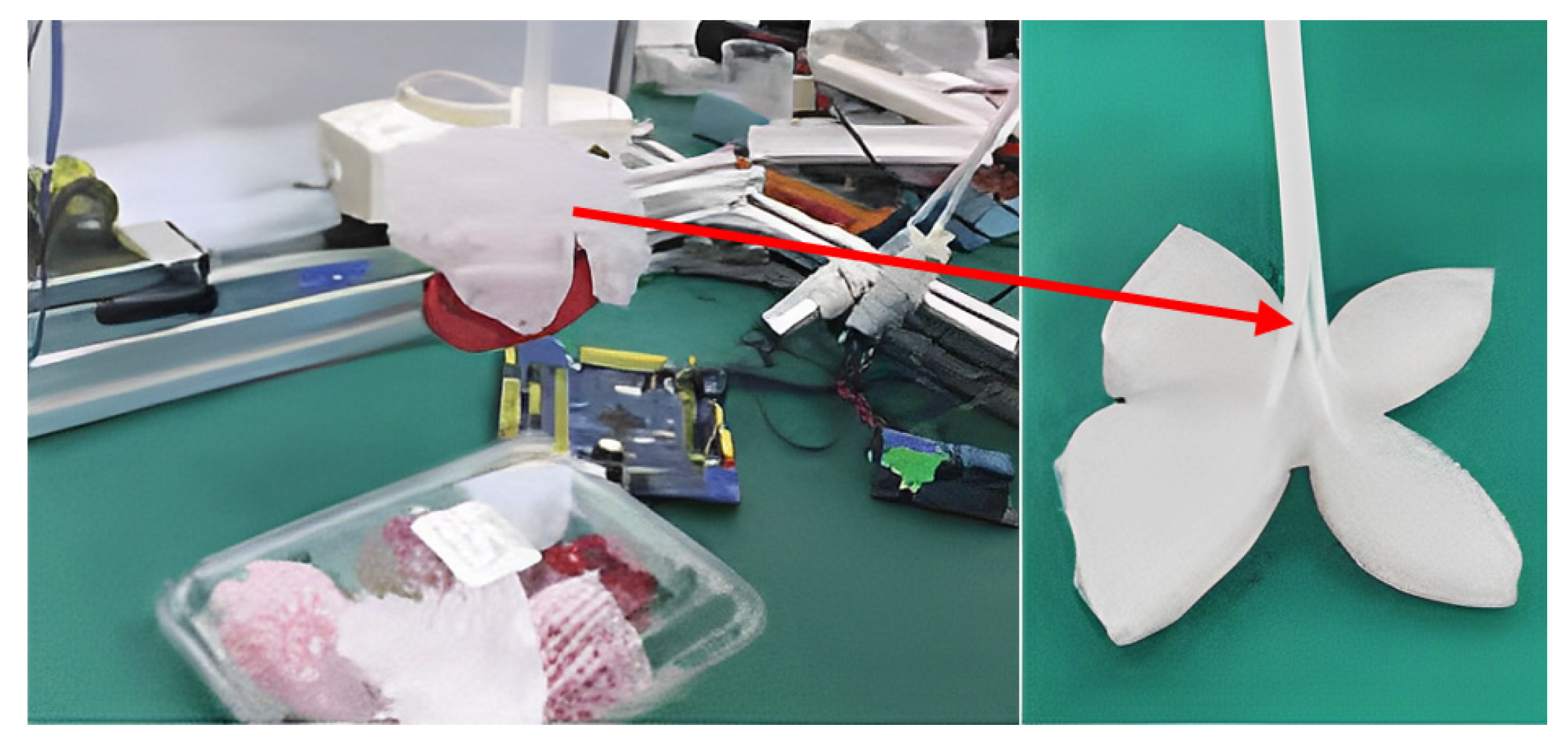
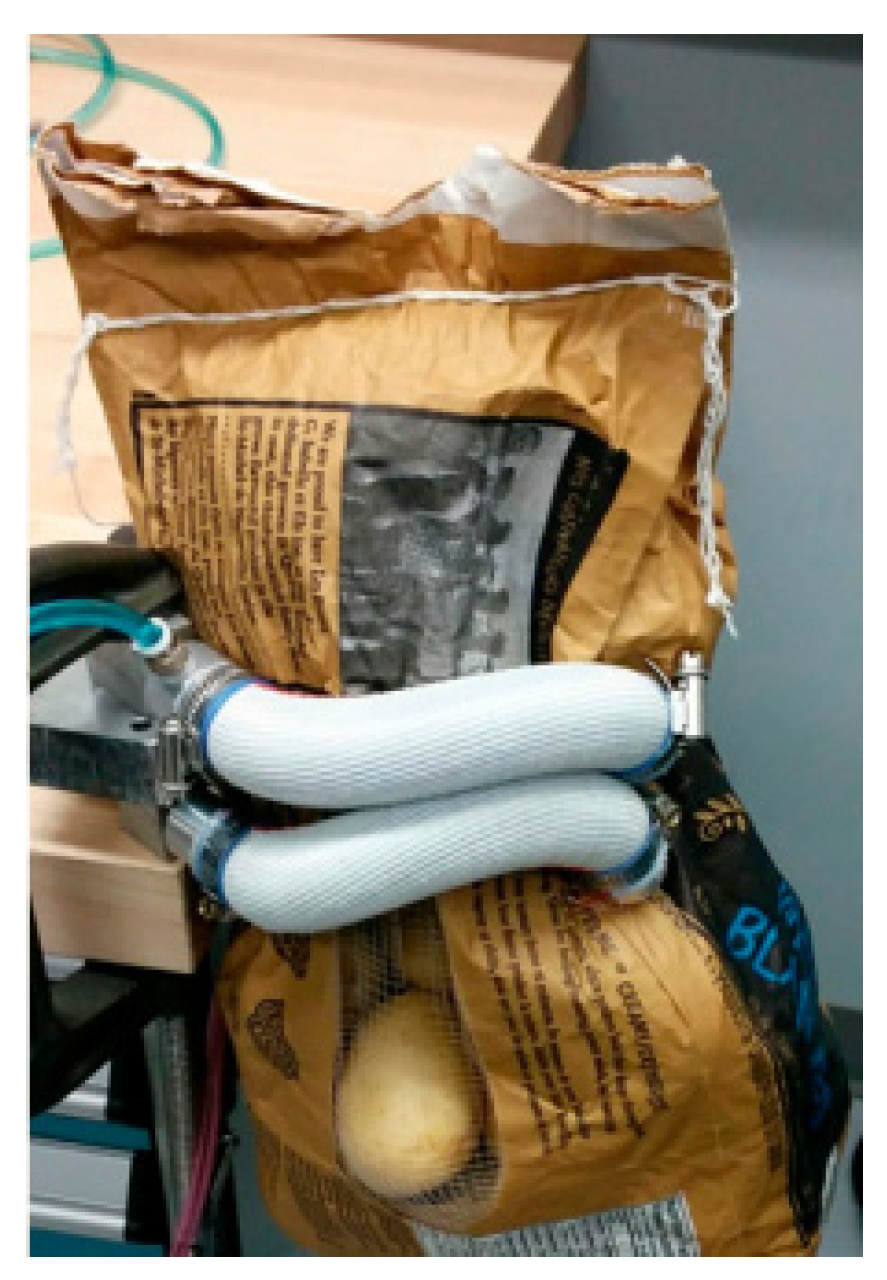
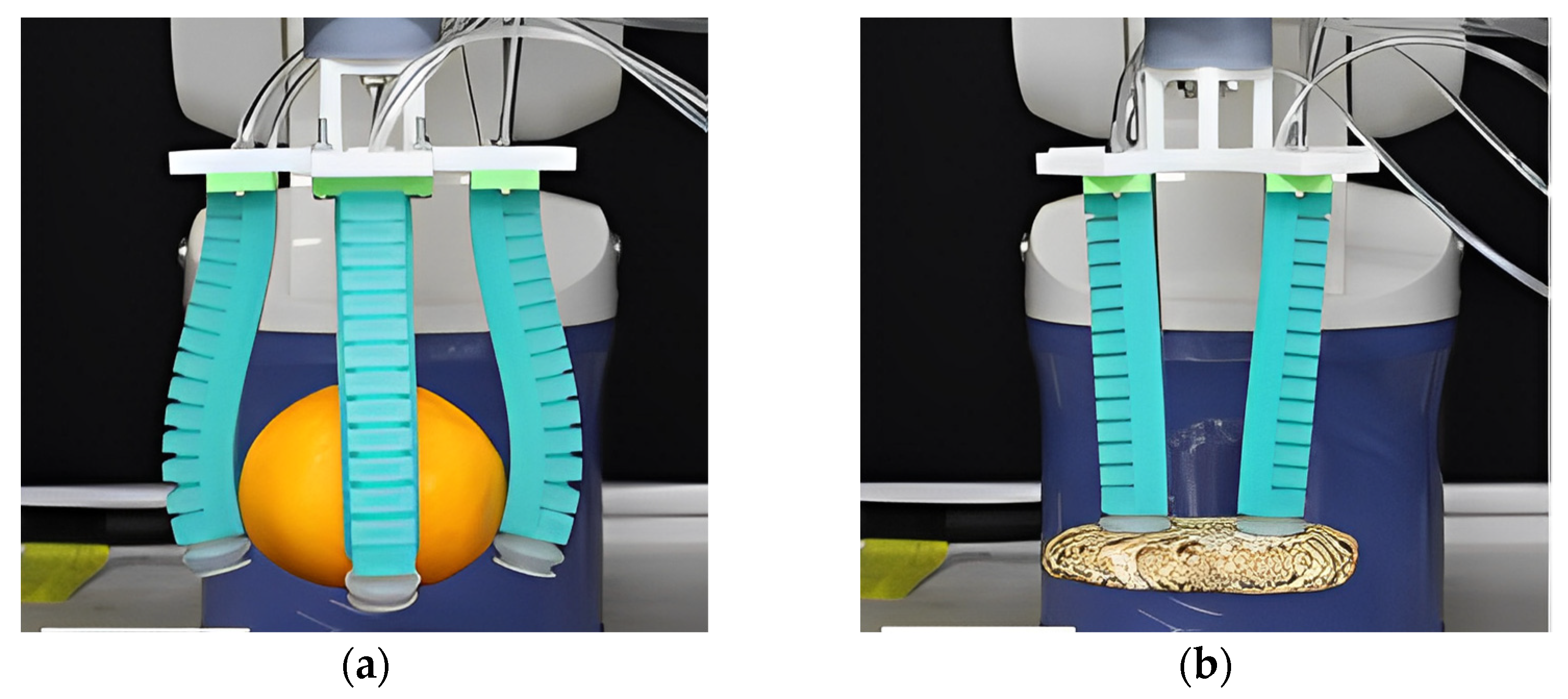
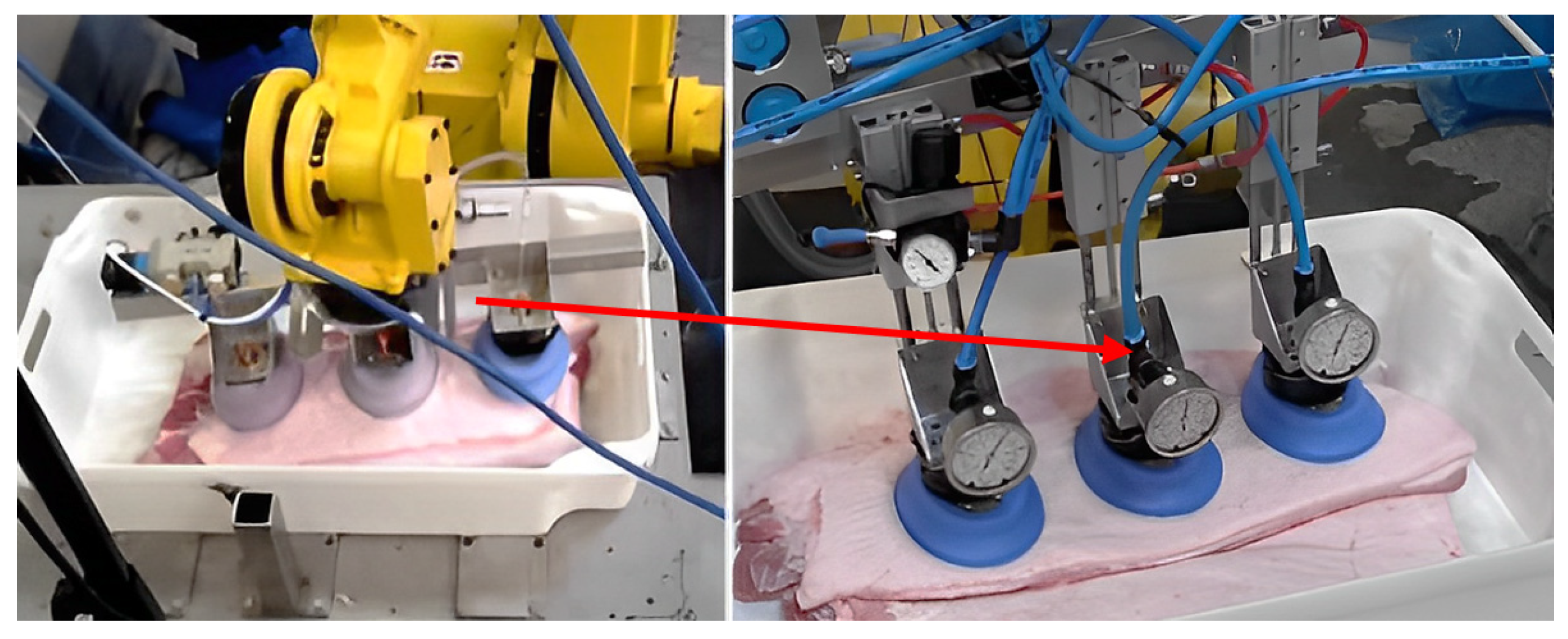
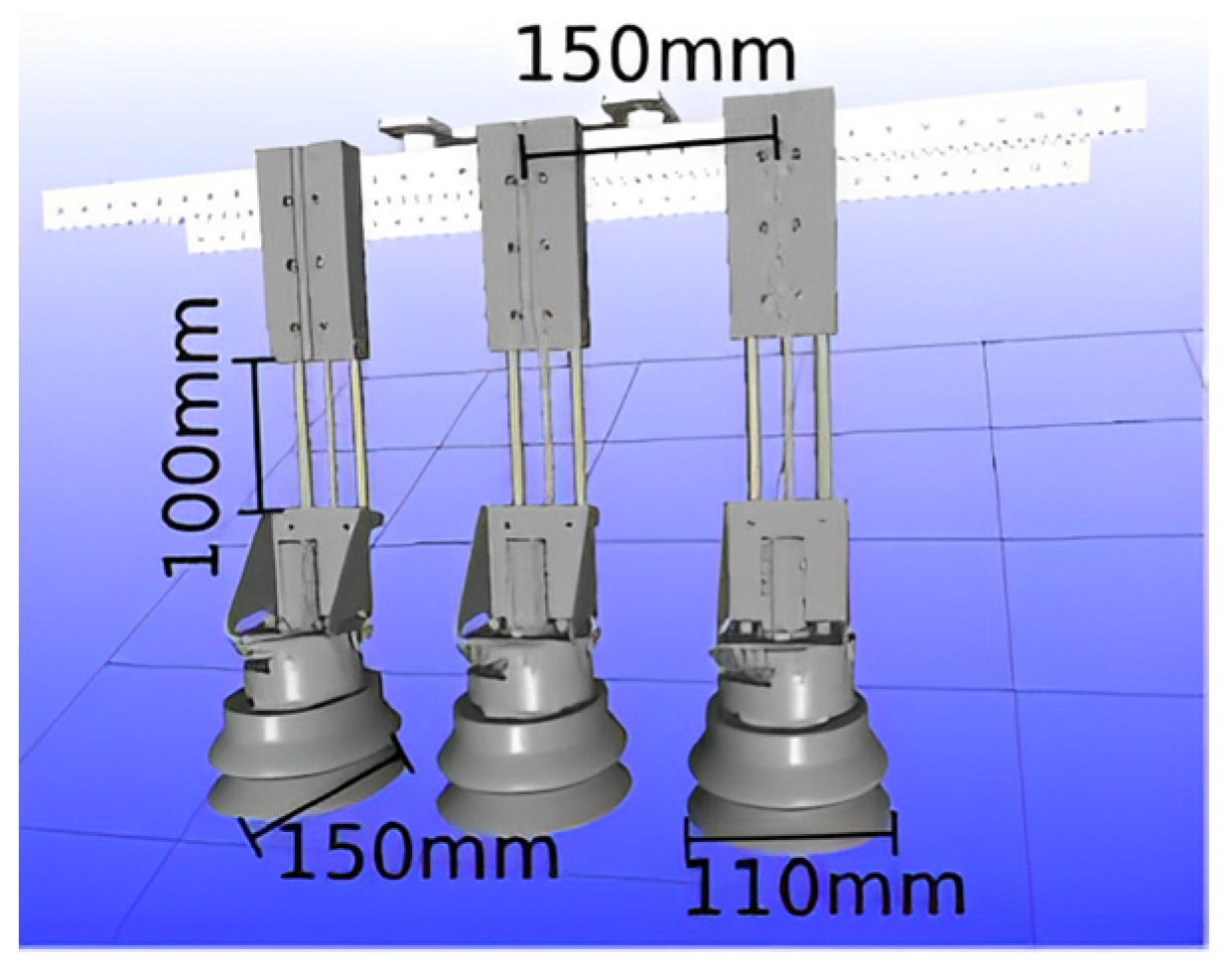
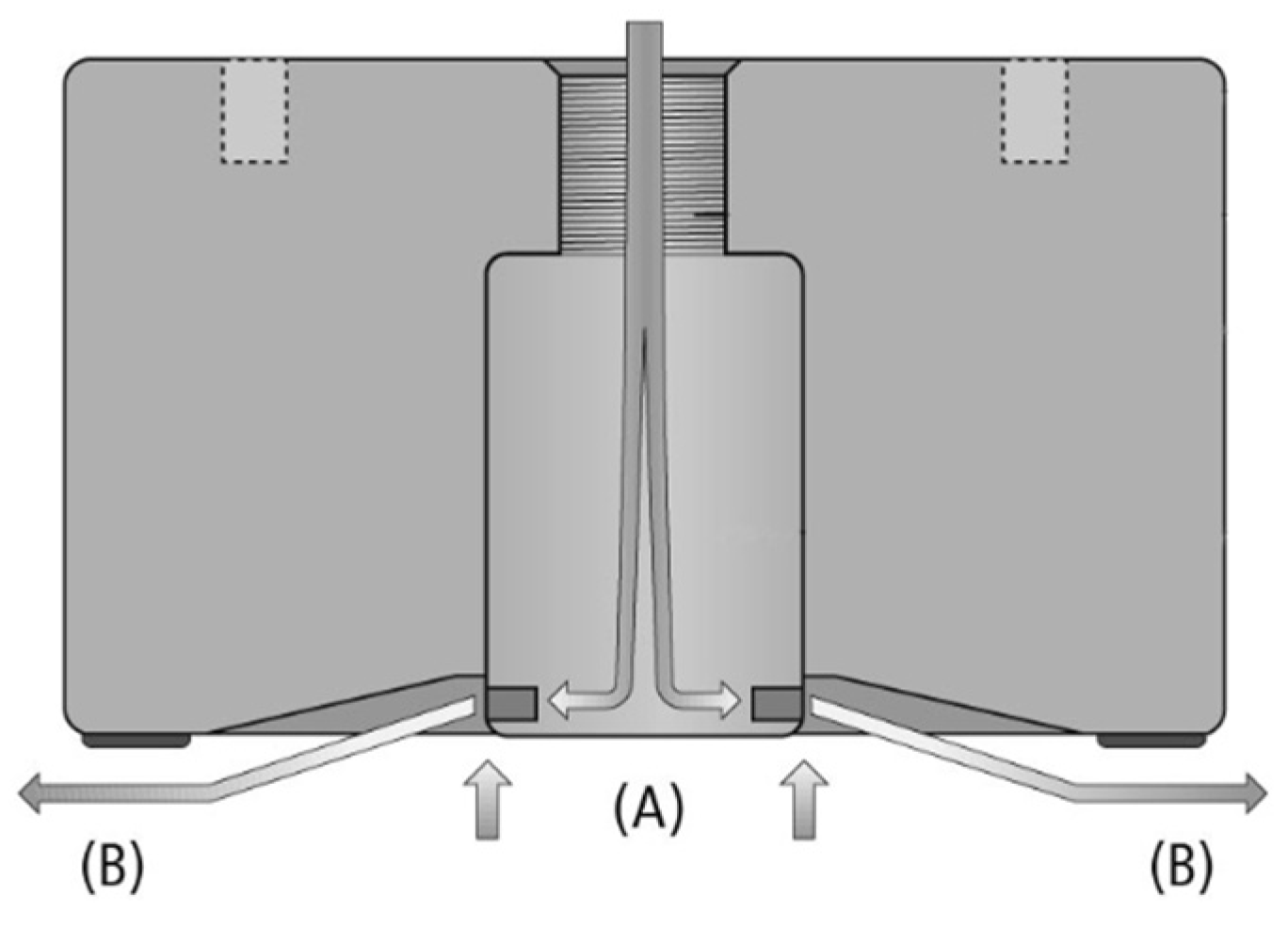
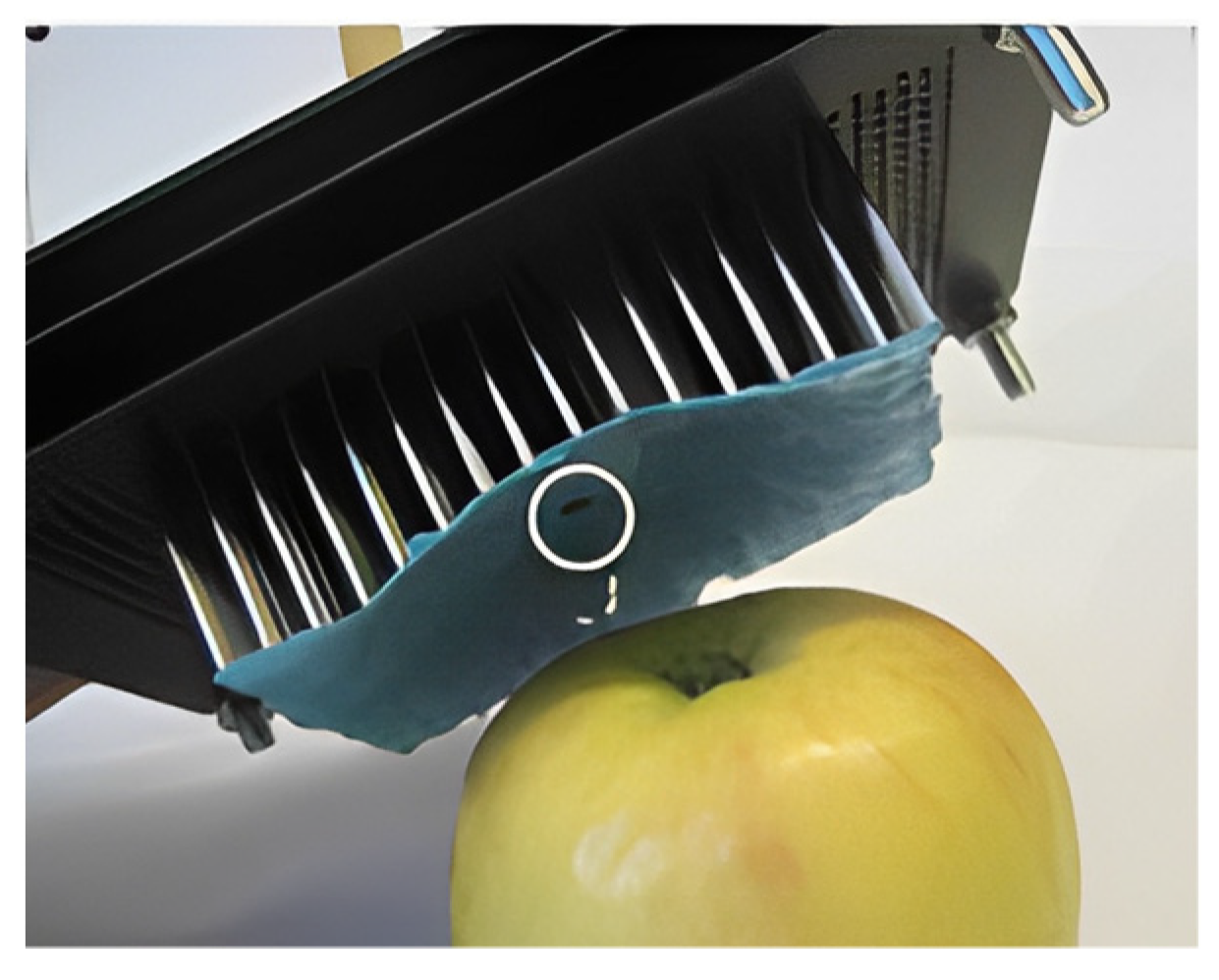
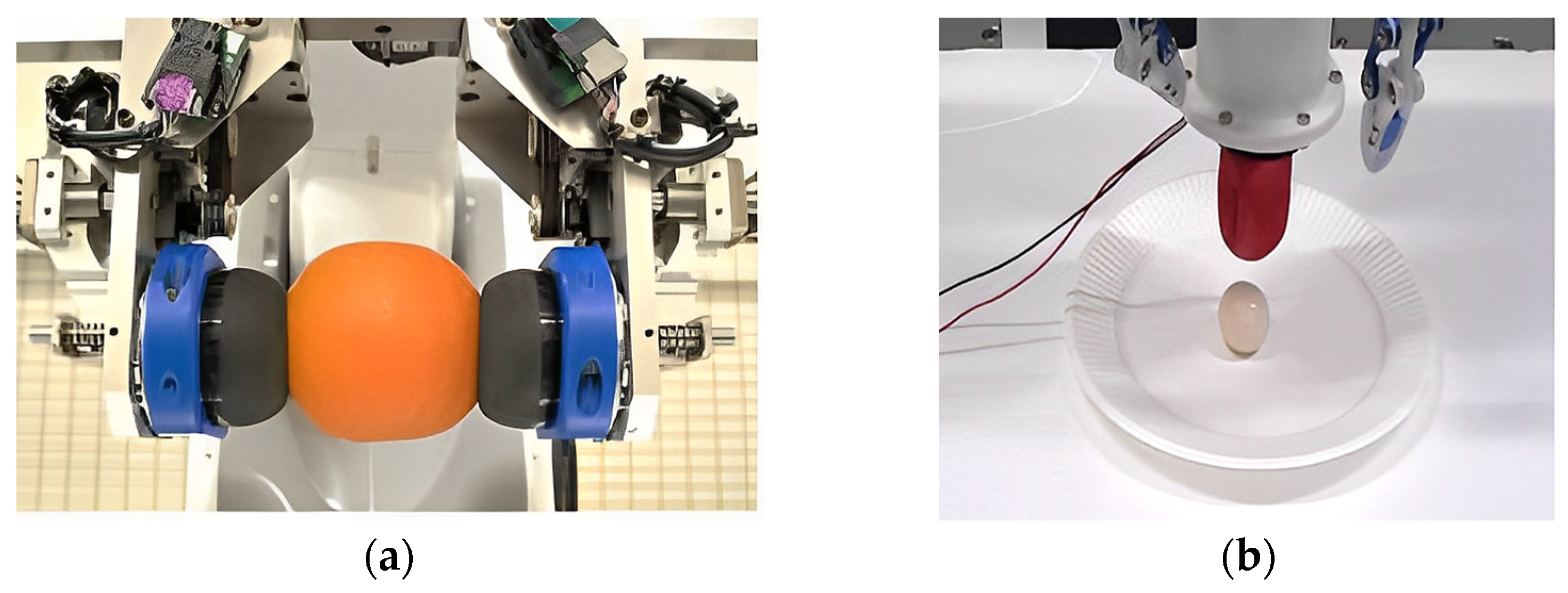
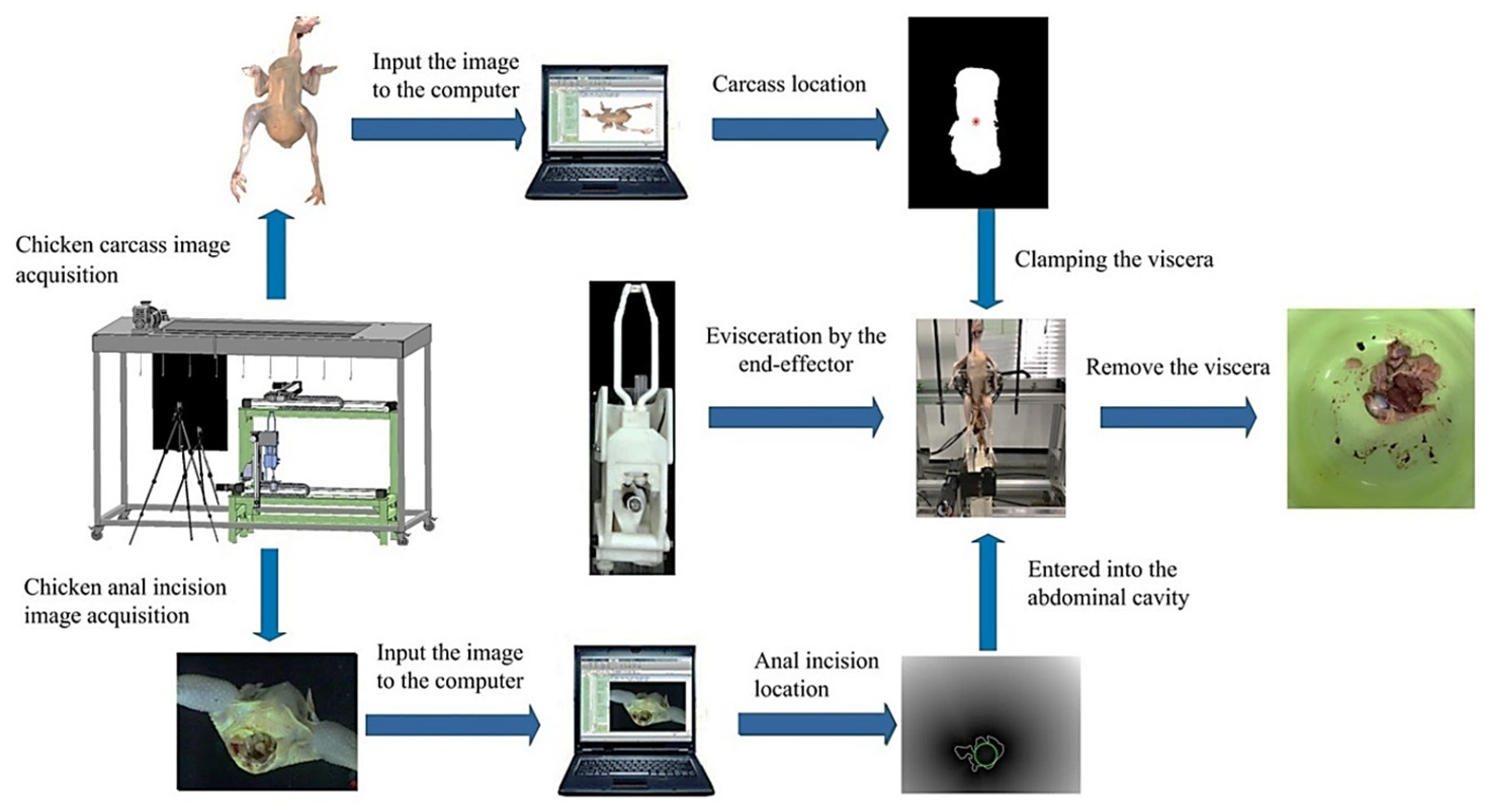
Disclaimer/Publisher’s Note: The statements, opinions and data contained in all publications are solely those of the individual author(s) and contributor(s) and not of MDPI and/or the editor(s). MDPI and/or the editor(s) disclaim responsibility for any injury to people or property resulting from any ideas, methods, instructions or products referred to in the content. |
© 2023 by the authors. Licensee MDPI, Basel, Switzerland. This article is an open access article distributed under the terms and conditions of the Creative Commons Attribution (CC BY) license (https://creativecommons.org/licenses/by/4.0/).
Share and Cite
Xu, Z.; Shi, W.; Zhao, D.; Li, K.; Li, J.; Dong, J.; Han, Y.; Zhao, J.; Bai, Y. Research Progress on Low Damage Grasping of Fruit, Vegetable and Meat Raw Materials. Foods 2023, 12, 3451. https://doi.org/10.3390/foods12183451
Xu Z, Shi W, Zhao D, Li K, Li J, Dong J, Han Y, Zhao J, Bai Y. Research Progress on Low Damage Grasping of Fruit, Vegetable and Meat Raw Materials. Foods. 2023; 12(18):3451. https://doi.org/10.3390/foods12183451
Chicago/Turabian StyleXu, Zeyu, Wenbo Shi, Dianbo Zhao, Ke Li, Junguang Li, Junyi Dong, Yu Han, Jiansheng Zhao, and Yanhong Bai. 2023. "Research Progress on Low Damage Grasping of Fruit, Vegetable and Meat Raw Materials" Foods 12, no. 18: 3451. https://doi.org/10.3390/foods12183451




